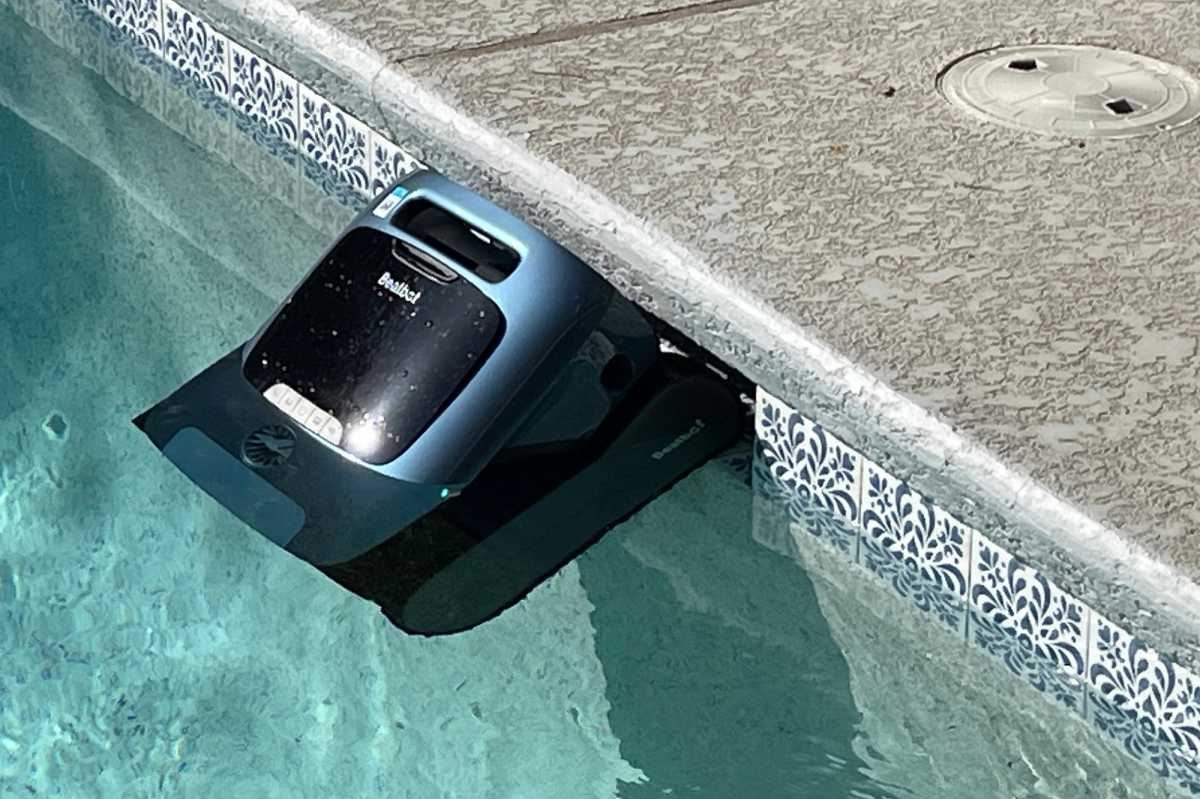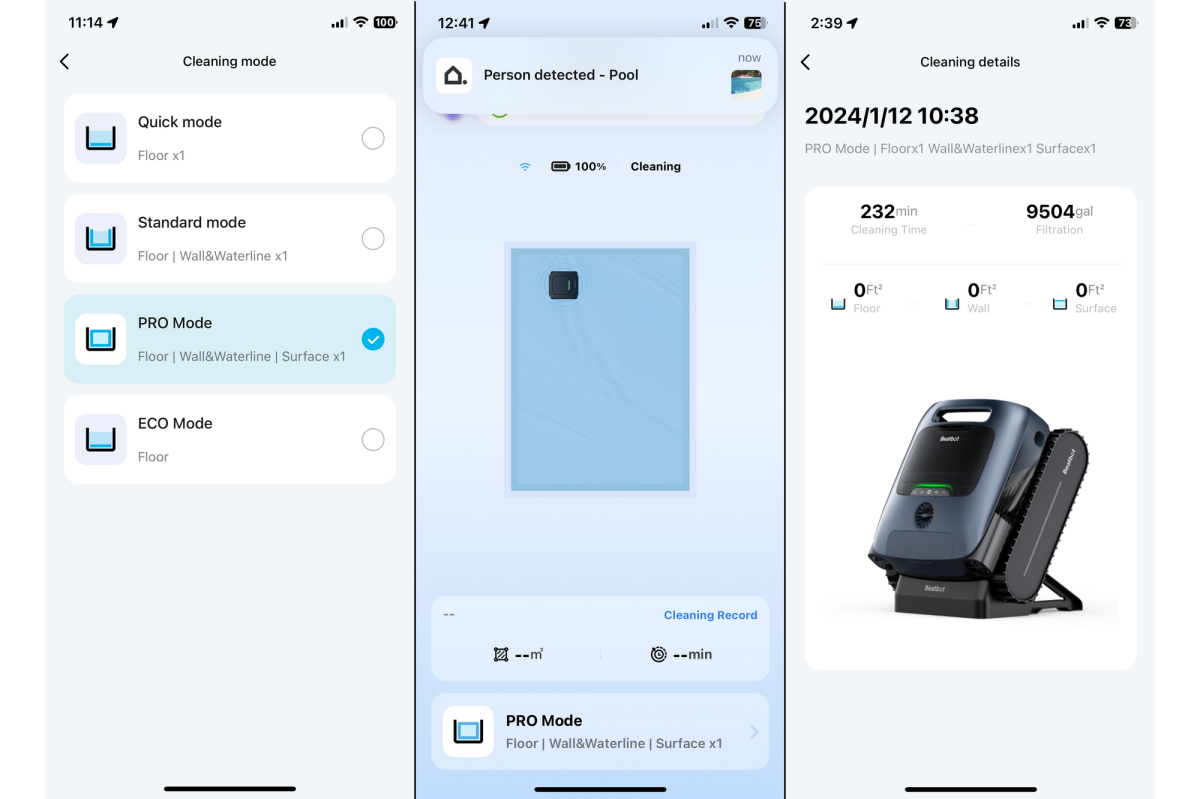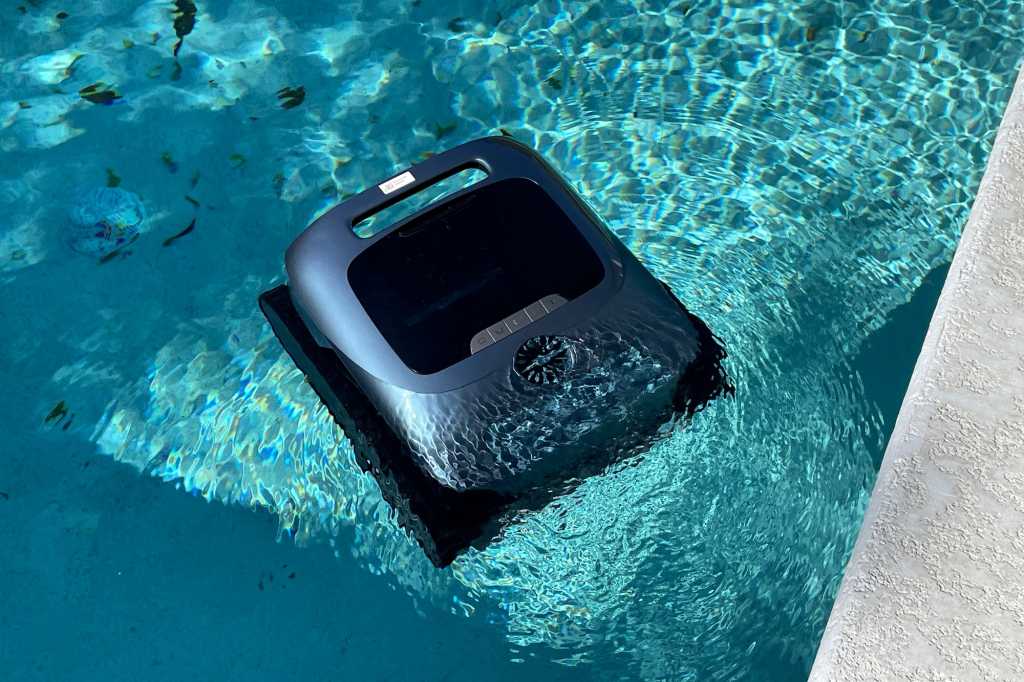Expert’s Rating
Pros
- Generally great cleaning performance, including on the pool’s surface
- Charging dock is easier and more convenient than the more typical plug and cable
- Floats to the surface for removal (most of the time)
- Optional water-clarification feature
Cons
- Easily gets stuck on obstacles in the pool
- At press time, its app didn’t working as advertised
- Extremely expensive
Our Verdict
The AquaSense Pro performs well, but its high price and various bugs temper our enthusiasm for it.
Best Prices Today: Aquasense Pro
Pool-cleaning robots continue to move upmarket, pouring on features and increasing their price tags along the way. Beatbot enters the market with some very big promises for its Aquasense Pro, and while it is the most luxe product I’ve seen in this category, significant bugs dampen my enthusiasm for it.
Design and build
Beatbot says its AquaSense Pro—equipped with nine motors, 20 sensors, and onboard AI—can clean five pool elements: floor, walls, waterline, and surface, while at the same time dispensing a chitosan cleaning agent to clarify the water itself. That fifth feature comes in the form of an optional kit that’s sold separately for $20 per treatment.
Cleaning performance was very good throughout my testing.
This is a beast of a robot, weighing 24 pounds and measuring about 17 x 16 x 10 inches. Onboard controls are quite basic, including a power button and four mode buttons that let you select which areas to clean: floor only, floor and walls, everything, or an eco mode that cleans the floor every two days (provided, I assume, you are willing to leave the robot in the pool for the long term). As is common with most pool cleaning robots, once you make your selection, you just drop the robot into the water and off it goes.
Specifications
- Wi-Fi connectivity: Yes
- Control: Android and iOS app; wireless remote
- Power source: Rechargeable battery (and charging dock)
- Maximum pool size: 3,229 square feet (300 square meters)
- Pool types: In-ground and above-ground; concrete, fiberglass, vinyl, ceramic tile
- Pool surfaces cleaned: Floor, walls, waterline, and the water’s surface
- Automatic return: Yes, robot returns to its starting point at job’s end
- Automatic water purge: Yes
Performance
The AquaSense Pro can skim leaves and other debris floating on the surface of the pool.
Christopher Null/Foundry
An AquaSense Pro cleaning run begins with the robot floating on the surface, with its motors kicking in to slowly spin it 360 degrees. The robot then angles itself down about 45 degrees and continues to spin and scan, before sinking itself to the floor, where it does another 360-degree survey. I don’t know exactly which sensors are in use here, but the AquaSense Pro does appear to make use of them, mapping the pool with care.
A full “pro” run of my 468-square-foot pool took about three hours, after which the robot still had about a quarter of its battery remaining. Its runs are largely lawnmower in style, moving in an S-shaped pattern as it goes back and forth from one wall to the other. It follows an N-shaped pattern to clean walls, climbing as high as it can before retreating, moving to the side, and going back down the wall. Surface cleaning is a little more haphazard, as I found water movement would tend to send the robot in a diagonal direction instead of straight back and forth.
Cleaning performance was very good throughout my testing, but not perfect—and not quite 100 percent, as the vendor promises. I ran numerous tests with different debris conditions, the first was after a heavy windstorm filled my pool with leaves. After 90 minutes, the AquaSense Pro abruptly quit and stayed on the floor, its debris basket completely full. Other tests found the robot cleaning almost everything; my synthetic test with silk leaves ended with just two leaves left in the pool, one on the floor and one on the surface. But another test found a fair amount of debris left behind, despite there not being much in the pool to begin with. Again, I found the robot cleaned better on the floor than the surface.

The AquaSense Pro can clean along a pool’s waterline in addition to the sides of its walls. When it finishes a cleaning run, it parks itself near the location it started.
Christopher Null/Foundry
After each run, the AquaSense Pro is supposed to bring itself to the surface and park next to the wall, ready for retrieval. I had pretty good luck with this feature, but on two occasions the AquaSense got trapped. One time it got wedged in the skimmer, and another it became stuck beneath a metal swim bar that runs horizontally across one section of the pool. These were both new experiences for me; I’ve never had another pool robot become stuck in either manner. Perhaps AI isn’t destined to destroy us after all.
After removal from the water, the robot continues to run for a few minutes to drain. I would use this time to clean out the filter basket, which is composed of two interlocking containers that allow it to collect a phenomenal amount of sandy debris. As with most robots, these baskets are easily cleaned with a hose and a few minutes of patience.
Instead of plugging in a cable to recharge the AquaSense Pro’s battery, you prop it up at an angle on its including charging dock. Two exposed electrodes charge the battery, similar to the way most robot vacuums do, and it helps drain any excess water. Note, however, that the robot does not dock itself.

Instead of plugging a cord into the AquaSense Pro to recharge its internal battery, you place in this charging dock.
Christopher Null/Foundry
The robot is supposed to come with a remote control, so you can direct the robot manually around the pool and tell it to climb to the surface on demand, but the remote was missing when I opened its box. Beatbot asked me to use the remote from an earlier version of the product, which I’d received while it was still undergoing beta testing. Unfortunately, I was never able to get this remote to pair with the shipping AquaSense Pro, so I couldn’t actively test it.
I also encountered trouble with Beatbot’s mobile app. For starters, you’re directed to set up the app using a QR code printed on the device, but the one on my review unit was too faded on arrival to scan properly. I was able to set the device up manually, however, and I used it to get basic information about the robot’s battery condition and its operating mode.

Beatbot’s app is one of the weaker aspects of this product; fortunately, it should also be the easiest for the company to fix.
Christopher Null/Foundry
The app is also supposed to generate a visual map of your pool based on the robot’s scans, but mine never became anything other than a rectangle. The system did log total cleaning time and filtration volume, but it has never budged from a total cleaning distance of 0 feet.
Should you buy the Beatbot AquaSense Pro?
With a retail price of $2,199 (there was a $500 pre-order discount available at press time, dropping its price to $1,699), the AquaSense Pro is a hard sell, even if everything worked perfectly out of the box. While it does a solid job of removing debris—especially dirt and other particulate matter—from the pool, I had higher hopes for its mobile app. The robot’s tendency to get stuck on common pool features is problematic as well.
I suspect firmware and software updates will remedy those issues over time; but for now, you can get your pool just as clean with a more affordable device, such as the Aiper Seagull Pro.

